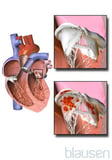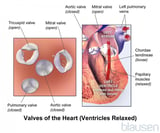Staph Infection After Blood Draw
-
These bacteria are spread by having direct contact with an infected person, by using a contaminated object, or by inhaling infected droplets dispersed by sneezing or coughing.
-
Skin infections are common, but the bacteria can spread through the bloodstream and infect distant organs.
-
Skin infections may cause blisters, abscesses, and redness and swelling in the infected area.
-
The diagnosis is based on the appearance of the skin or identification of the bacteria in a sample of the infected material.
-
Thoroughly washing the hands can help prevent spread of infection.
-
Antibiotics are chosen based on whether they are likely to be effective against the strain causing the infection.
Staphylococcus aureus is present in the nose (usually temporarily) of about 30% of healthy adults and on the skin of about 20%. The percentages are higher for people who are patients in a hospital or who work there.
The bacteria can spread from person to person by direct contact, through contaminated objects (such as gym equipment, telephones, door knobs, television remote controls, or elevator buttons), or, less often, by inhalation of infected droplets dispersed by sneezing or coughing.
Carriers are people who have the bacteria but do not have any symptoms caused by the bacteria. Carriers can move the bacteria from their nose to other body parts with their hands, sometimes leading to infection. People who are hospitalized or work in a hospital are more likely to be carriers.
Staphylococcus aureus infections range from mild to life threatening.
The most common staphylococcal infections are
However, the bacteria can travel through the bloodstream (called bacteremia Bacteremia Bacteremia is the presence of bacteria in the bloodstream. Bacteremia may result from ordinary activities (such as vigorous toothbrushing), dental or medical procedures, or from infections ... read more ) and infect almost any site in the body, particularly heart valves (endocarditis Infective Endocarditis Infective endocarditis is an infection of the lining of the heart (endocardium) and usually also of the heart valves. Infective endocarditis occurs when bacteria enter the bloodstream and travel... read more  ) and bones (osteomyelitis Osteomyelitis Osteomyelitis is a bone infection usually caused by bacteria, mycobacteria, or fungi. Bacteria, mycobacteria, or fungi can infect bones by spreading through the bloodstream or, more often, by... read more ).
) and bones (osteomyelitis Osteomyelitis Osteomyelitis is a bone infection usually caused by bacteria, mycobacteria, or fungi. Bacteria, mycobacteria, or fungi can infect bones by spreading through the bloodstream or, more often, by... read more ).
The bacteria also tend to accumulate on medical devices in the body, such as artificial heart valves or joints, heart pacemakers, and catheters inserted through the skin into blood vessels.
Certain staphylococcal infections are more likely in certain situations:
-
Bloodstream infections: When a catheter that is inserted in a vein has remained in place for a long time
-
Endocarditis: When people inject illegal drugs or have an artificial heart valve or when a catheter inserted in a vein is infected
-
Osteomyelitis: When Staphylococcus aureus spreads to the bone from an infection in the bloodstream or from an infection in nearby soft tissue, as may occur in people with deep pressure sores or foot sores due to diabetes
Certain conditions increase the risk of getting a staphylococcal infection:
-
Tumors
-
A transplanted organ Overview of Transplantation Transplantation is the removal of living, functioning cells, tissues, or organs from the body and then their transfer back into the same body or into a different body. The most common type of... read more , an implanted medical device (such as artificial heart valves Repairing or replacing a heart valve Heart valves regulate the flow of blood through the heart's four chambers—two small, round upper chambers (atria) and two larger, cone-shaped lower chambers (ventricles). Each ventricle has... read more
 , joints Hip replacement Hip fractures may occur in the round upper end (head) of the thighbone, in the narrow part of the thighbone just below the head (neck), or in the bumps in the broader area just below the neck... read more , or heart pacemakers Artificial pacemakers Abnormal heart rhythms (arrhythmias) are sequences of heartbeats that are irregular, too fast, too slow, or conducted via an abnormal electrical pathway through the heart. Heart disorders are... read more
, joints Hip replacement Hip fractures may occur in the round upper end (head) of the thighbone, in the narrow part of the thighbone just below the head (neck), or in the bumps in the broader area just below the neck... read more , or heart pacemakers Artificial pacemakers Abnormal heart rhythms (arrhythmias) are sequences of heartbeats that are irregular, too fast, too slow, or conducted via an abnormal electrical pathway through the heart. Heart disorders are... read more  ), or a catheter inserted into a vein for a long time
), or a catheter inserted into a vein for a long time -
An open wound or sore
-
Chronic skin disorders
-
Surgery
-
Drugs, such as corticosteroids, drugs that suppress the immune system (immunosuppressants), or cancer chemotherapy
-
Radiation therapy
-
Injection of illegal drugs
-
Newborns and breastfeeding mothers
Whether the bacteria are resistant and which antibiotics they resist often depend on where people got the infection: in a hospital or other health care facility or outside of such a facility (in the community).
MRSA strains are common when infection is acquired in a health care facility (called hospital-acquired infection). Some strains of MRSA cause infections that are acquired outside of a health care facility (called community-acquired infection), including mild abscesses and skin infections. The number of these community-acquired infections is increasing.
Skin infections due to Staphylococcus aureus can include the following:
All staphylococcal skin infections are very contagious.
Bloodstream infection is a common cause of death in people with severe burns. Symptoms typically include a persistent high fever and sometimes shock.
Osteomyelitis causes chills, fever, and bone pain. The skin and soft tissues over the infected bone become red and swollen, and fluid may accumulate in nearby joints.
-
For skin infections, a doctor's evaluation
-
For other infections, culture of blood or infected body fluids
Staphylococcal skin infections are usually diagnosed based on their appearance.
People can help prevent the spread of these bacteria by always thoroughly washing their hands with soap and water or applying an alcohol-based hand sanitizer.
Some doctors recommend applying the antibiotic mupirocin inside the nostrils to eliminate staphylococci from the nose. However, because overusing mupirocin can lead to mupirocin resistance, this antibiotic is used only when people are likely to get an infection. For example, it is given to people before certain operations or to people who live in a household in which the skin infection is spreading.
If carriers of staphylococci need to have certain types of surgery, they are often treated with an antibiotic before the surgery.
People with a staphylococcal skin infection should not handle food.
In some health care facilities, people are routinely screened for MRSA when they are admitted. Some facilities screen only people who are at increased of getting a MRSA infection, such as those who are about to have certain operations. Screening involves testing a sample taken from the nose with a cotton swab. If MRSA strains are detected, people are isolated to prevent spread of the bacteria.
-
Antibiotics
-
Sometimes surgical removal of infected bone and/or foreign material
Infections due to Staphylococcus aureus are treated with antibiotics. Doctors try to determine whether the bacteria are resistant to antibiotics and, if so, to which antibiotics.
Infection that is acquired in a hospital is treated with antibiotics that are effective against MRSA. They include vancomycin, linezolid, tedizolid, quinupristin plus dalfopristin, ceftaroline, telavancin, or daptomycin. If results of testing later indicate that the strain is susceptible to methicillin and the person is not allergic to penicillin, a drug related to methicillin, such as nafcillin or oxacillin, is used. Depending on how severe the infection is, antibiotics may be given for weeks.
MRSA infection can be acquired outside of a health care facility. The community-acquired MRSA strains are usually susceptible to other antibiotics, such as trimethoprim/sulfamethoxazole, clindamycin, minocycline, or doxycycline, as well as to the antibiotics used to treat MRSA infections acquired in the hospital.
Mild skin infections due to MRSA, such as folliculitis, are usually treated with an ointment, such as one that contains bacitracin, neomycin, and polymyxin B (available without a prescription) or mupirocin (available by prescription only). If more than an ointment is required, antibiotics effective against MRSA are given by mouth or intravenously. Which antibiotic is used depends on the severity of the infection and the results of susceptibility testing.
If an infection involves bone or foreign material in the body (such as heart pacemakers, artificial heart valves and joints, and blood vessel grafts), rifampin and possibly another antibiotic are sometimes added to the antibiotic regimen. Usually, infected bone and foreign material has to be removed surgically to cure the infection.
Abscesses, if present, are usually drained.
Staphylococcus aureus produces an enzyme called coagulase. Other species of staphylococci do not and thus are called coagulase-negative staphylococci. These bacteria normally reside on the skin of all healthy people.
These bacteria, although less dangerous than Staphylococcus aureus, can cause serious infections, usually when acquired in a hospital. The bacteria may infect catheters inserted through the skin into a blood vessel or implanted medical devices (such as heart pacemakers or artificial heart valves and joints).
These bacteria are often resistant to many antibiotics. Vancomycin, which is effective against many resistant bacteria, is used, sometimes with rifampin. Medical devices, if infected, often must be removed.
Staph Infection After Blood Draw
Source: https://www.msdmanuals.com/home/infections/bacterial-infections-gram-positive-bacteria/staphylococcus-aureus-infections
0 Response to "Staph Infection After Blood Draw"
Post a Comment